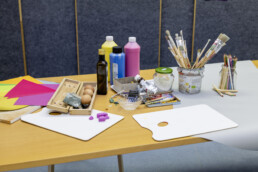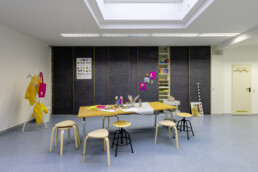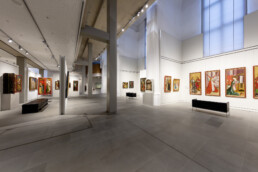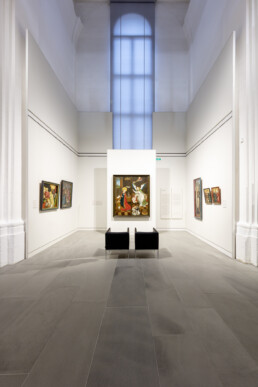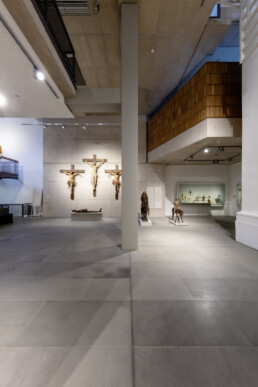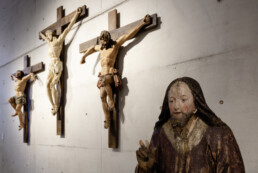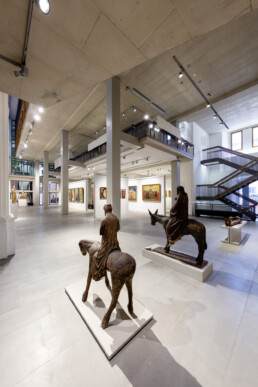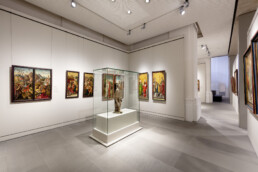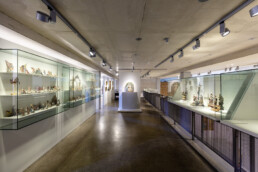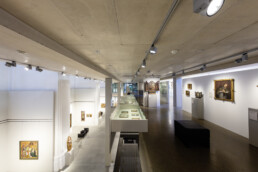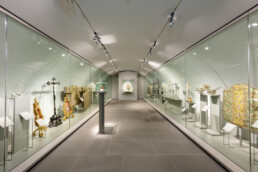Functions
In 1894, Bishop Paul Wilhelm von Keppler (1852-1926) published a “museum programme” in which he defined three main tasks for the Diocesan Museum Rottenburg:
- Collection point for neglected and unused art objects in order to protect them from decay and sale, to care for them and to administer them.
- Creation of a museum catalogue.
- Introduction of young theologians and the clergy in general to the spirit and history of religious art.
With these principles, Bishop Keppler was already addressing areas of responsibility that museums still perform today: collecting, preserving, researching and communicating the holdings.
Since its foundation, the Diocesan Museum Rottenburg has served as a dignified repository of religious art. However, objects from parishes that are no longer used have been stored in the former Obermarchtal monastery since the establishment of a diocesan depot in 1986. The diocesan depot in Obermarchtal is looked after by the Episcopal Building Office, as is the parament chamber established in Sießen Monastery in 2014. Only objects from parishes or private ownership that are of high art-historical or idealistic quality and fit into the collection concept are accepted by the Diocesan Museum. The museum itself has a depot in the museum building that meets the high conservation requirements for the storage of particularly fragile and old works of art.
The Diocesan Museum documents and manages the sacred works of art and ensures their preservation through careful conservation and restoration. The two catalogues published to date as well as various smaller publications on specific areas of the collection serve to make the holdings accessible.
A great deal of space – in a much broader framework than Bishop Keppler still defined – is devoted to communicating sacred art in a contemporary context. To this end, a wide range of museum educational programmes are offered, addressing different target groups. In addition to classical formats, various ways of accessing art and its contents are used: discussions, workshops, impulses, music, dance and the visitor’s own creative work. The Diocesan Museum sees itself as a place of encounter and lively exchange in which religious and social questions are addressed through the medium of art. All the more so because the museum also presents exhibitions of contemporary art that enter into dialogue with traditional Christian works of art. It is precisely the discourse with contemporary artists that plays a major role in the institution’s self-image.
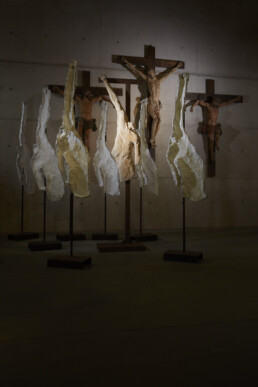
Building
The museum is located in the former church of the profaned Carmelite monastery in Rottenburg. Plans for housing it there were already made in 1987, when a new solution was also sought for the diocesan library. Since 1916, the library had been housed in the Baroque church of the Carmelite monastery founded by Albrecht II of Hohenberg in 1276, which had been profaned in 1817. However, the installations initially made for living quarters and administrative rooms in the church were no longer able to cope with the ever-increasing load of books. This led to considerations to create new accommodation for the two institutions, the diocesan library and the diocesan museum, on this site in the housing of the former sacred architecture.
After a competition in 1988 with 49 participating architects, the competition winner, the Stuttgart architect Eckehard Janofske, was awarded the contract to realise his project. In the execution of Janofske’s concept, after the complete removal of the 19th century fixtures, a kind of concrete shelf supported by pillars was set up for the diocesan library, which is located above the museum rooms. The “house-within-a-house” concept pursued by the architect clearly separates old from new and at the same time makes it possible to experience the former Baroque interior again in its original height and depth. The baroque space, defined by wall pillars forming high niches, allows the exhibited works to come into their own.
At the same time, a previously non-existent basement was excavated to provide further exhibition space, not least a special exhibition room. The museum’s “treasure chamber” with its paraments and gold and silversmith’s work was housed in the extended vault under the choir, which had already been created in earlier times for heating purposes.
On 1 March 1991, the ground-breaking ceremony for the conversion took place, and on 14 September 1996, the Diocesan Library and Diocesan Museum were inaugurated and opened in a ceremonial act by Bishop Dr Walter Kasper, who was elevated to Cardinal in 2001.
ArtAlley - KunstGasse
Welcome to the ArtAlley – KunstGasse – our new workshop, right next to the Diocesan Museum!
From now on you can be creative yourself, implement your own ideas, paint, do handicrafts and design.
An annually changing educational programme is planned with creative workshops and art activities around the Diocesan Museum.
We look forward to colourful splashes of paint and first works of art with you!
Where can I find the ArtAlley – KunstGasse?
You will find the entrance to our ArtAlley – KunstGasse directly to the left of the Theo bookshop, Karmeliterstraße 2 in Rottenburg.
Team
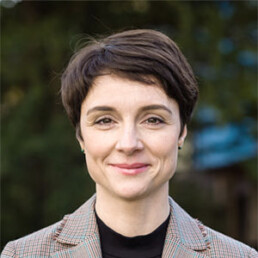
Diocesan Conservator Dr. phil. Melanie Prange
Direction
Phone: +49 (0) 7472 922-180
museum@bo.drs.de

Federica Viviani M. A.
Scientific assistant
Phone: +49 (0) 7472 922-305
fviviani@bo.drs.de
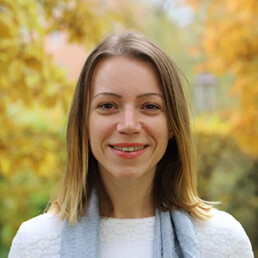
Dr. Nadine Niester
Editorial Office “Heilige Kunst (Sacred Art)”
Phone: +49 (0) 7472 169 960
nniester@bo.drs.de
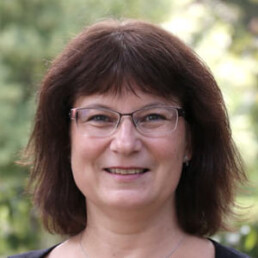
Hildegard Weidenauer
Secretariat
Phone: 07472 922-180
hweidenauer@bo.drs.de
Art inventory
Christine Bozler-Kießling M.A.
Dr. phil. Iris Dostal-Melchinger
Sebastian Eckert
Tamara Engert
Sülchen branch
Matthias Raidt
Guides
Judith Welsch-Körntgen
Jörg Widmann
Reception
Anne Baur
Anja Baur
Iris Birnbaum
Loredana Columbo
Victoria Hammer
Ruth Teufel
Maria Anna Wehle
Rosemarie Wiedmaier
Tobias Wiedmaier
Impressions
With the panorama 3D tour or our collection of short video documentaries.
Press
Press photos for download (after zooming in, save the image with the right mouse button or download all images as a ZIP archive [104MB]).
